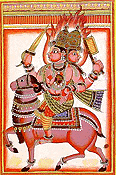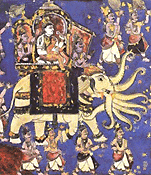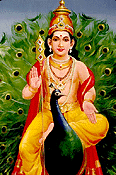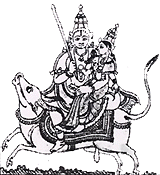
|
|
|
|
BY: SUN STAFF

Rajasthan, c. 1800 British Museum Collection Jan 27, 2014 — CANADA (SUN) — The vahana carriers of the demigods and goddesses, and the makaras and aquatic carriers.
Shiva's consort, Durga (like Parvati, Uma, Chandi and Kali), uses a lion as her vehicle. The lion represents her heroic prowess. As she rides on the lion to trample down Mahisasura, she represents the subduer of vices. Durga is often shown placed between Laksmi and Sarasvati, representing mundane opulence and mundane knowledge. Saraswati rides Hamsa the Swam, or sometimes a peacock. The swan is a symbol of spiritual purity, and those who have transcended the material nature are sometimes called supreme swans, or "paramahamsa". Lakshmi rides on an owl named Uluka. Uluka, which means 'owl' in Sanskrit, is also one of the names of lndra, the king of the demigods, who personifies wealth, power and glory. Thus, Lakshmi, the goddess of fortune, rides on a fitting carrier. The comparison of Indra's glory to a partially blind bird speaks to the difference between material and spiritual wealth, as Lakshmi is the goddess of spiritual wisdom.



Agni's carrier is usually depicted as a ram, and sometimes he is carried on a chariot pulled by goats.
The Supreme Personality of Godhead said, "Of lordly elephants I am Airavata", thus Airavata is the king of all elephants. Airavata (Airaawat) is the vehicle of Lord Indra, king of the demigods.
The demigods and demons (asuras) once took a sea journey. On this journey, nectar and poison were produced, and Lord Siva drank the poison. From the nectar were produced many entities, one of which was the elephant Airavata. As a result of the devas and asuras churning, the king of elephants was generated, being white, with four tusks. Airavata deified the glories of Kailasa Mountain, the glorious abode of Lord Siva.
Seated on his peacock vahana named Indranilaratha, Karttikeya is the embodiment of youth, beauty and valour. The peacock, "mayura" in Sanskrit, symbolizes Karttikeya's effulgent beauty.
Karttikeya is the second son of Siva, the brother of Ganesha. A great Mahadeva worshiped in all parts of India and the world, he is also known as Murugan, Kumara, Skanda, Shanmukhanatha and Subramanya. All these forms are depicted as riding on or being associated with, the peacock.
Vayu, the god of wind, rides an antelope, and is sometimes transported in a shining chariot pulled by two, forty-nine, or a thousand horses.
Lord Yamaraja's vehicle is a water buffalo. Yama is usually depicted with green skin, two or four arms holding a gada (club) and riding on a black buffalo. Yama's Buddhist counterpart has the head of a buffalo and rides a blue bull.
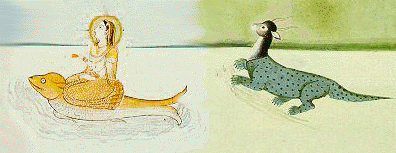
The Supreme Personality of Godhead said, "Of all the aquatics, I am the makara". Numerous demigods and deities who are associated with water have makaras as their carriers. Varuna (Praceta), the predominating deity of the waters, rides a makara, as does Kamadeva, who sometimes rides a parrot. The Triveni devi ride sea creatures, with Yamuna on a turtle or fish, and Saraswati and Ganga Ma on makaras. 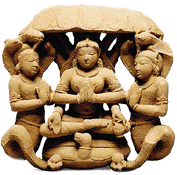
Yamuna on Turtle, with Ganga and Saraswati makaras
Makaras are sometimes depicted in the form of a crocodile or alligator, as in the case of Lord Varuna's vehicle. Ganga Ma's makara is sometimes depicted with the head of an elephant and the body of a fish. In eastern astrology, the makara is often translated as a 'Water Horse', which corresponds to the western astrological sign of Capricorn, depicted as having the head of a goat and the body of a fish.

| |
